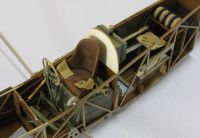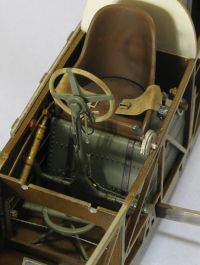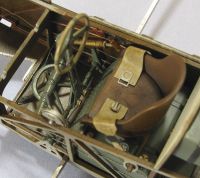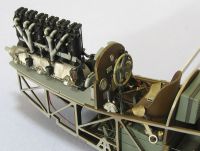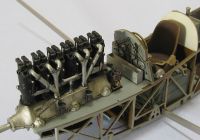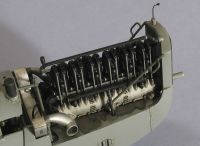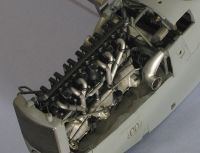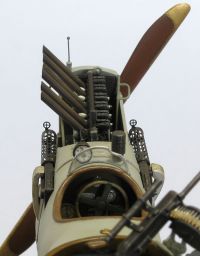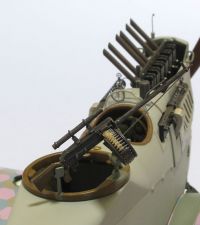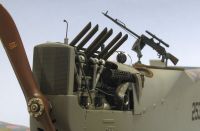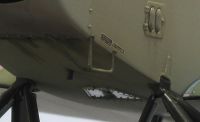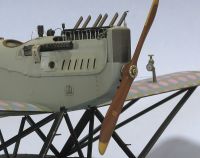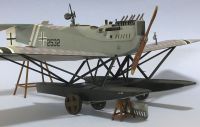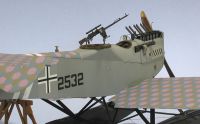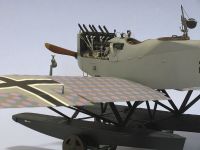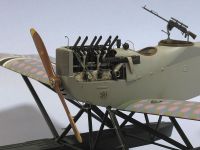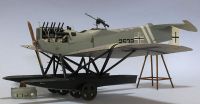Wingnut Wings 1/32 Hansa-Brandenburg W.29 C3MG
By Bruce Salmon
Wingnut Wings – Hansa-Brandenburg W.29 C3MG 1/32 Seeflugstation, Norderney. September-October 1918
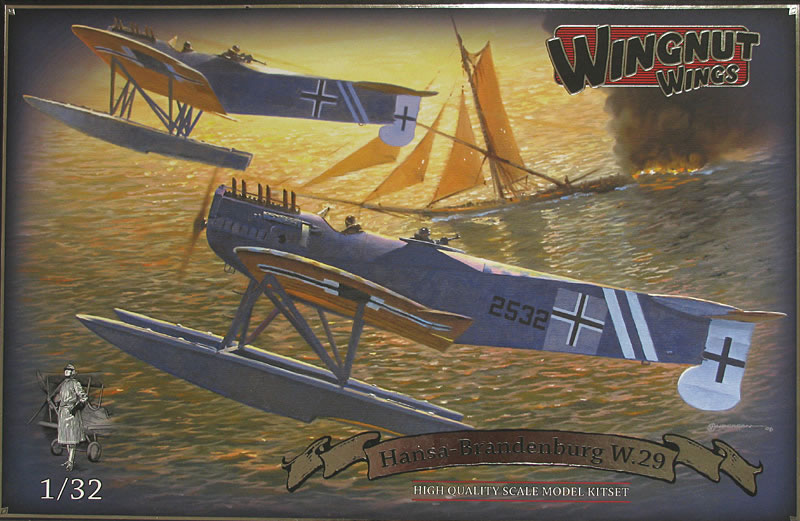
INTRODUCTION
The Hansa-Brandenburg W.29 has got to be one of the sexiest seaplanes of WWI and looks something akin to an enormous grey moth. When Wingnut Wings released the Hansa I bought one immediately and it went straight to the top of my modelling pile. The kit builds into quite a large model being some 29cm long by 41cm wide but is very sturdy considering how thin the parts are and how heavy the model is.
WINGNUTS KITS
This is the third Wingnuts kit I have attempted, and while I agree with the masses that these are definitely the best WWI aircraft in 1/32 scale they are certainly not without their shortcomings. Here is a fairly concise list of all the problems with this kit (some may be specific to mine). Most of these issues are minor but the non-fitting outer float struts are a real pain in the arse.
- Decals not in register
- Excess film edging around instrument decals
- Wings have a very thick trailing edge
- Wings have a distinct step at underside panel join
- Lots of engine bay shenanigans
- Holes for front and rear cockpit control wires don’t line up
- Cowl panels not long enough
- Wing outer float struts non-fitting
- Some construction steps in wrong order
- Clear plastic parts were wrinkled
In general it is quite obvious that the various kits were CADed by different people as some are well thought out while others seem to be copies of other manufacturer’s out-dated methods. They feel like they have been picked up then put down several times as some basic things get forgotten and also feel as though they have been rushed somewhat. Most of the CADers work in the film industry so maybe they work on the Wingnuts kits in their down time which would explain the QC issues.
Another weird thing is that there are two sets of beaching dollies in this kit; one with wooden wheels and the other spoked - yet there are no PE spokes. Why would you even bother casting the spoked wheel set if you didn’t intend to supply the spokes? Very WTF!
CONSTRUCTION
Following the kit instructions for a WWI kit is not always practical as you have to take into account rigging and painting issues. Therefore you need to get familiar with the parts and work out a plan of attack before proceeding. Getting the process wrong can necessitate the use of magic words, of which I am well practised. I usually build and paint parts in subassemblies where possible to make it a bit easier on the ol’ noggin.
COCKPIT / FUSELAGE
First the seat (with seatbelts), fuel tank, auxiliary fuel tank were painted and glued to the bulkhead (interestingly the pilot's seat is offset to starboard). I painted parts D5 but left them off until the rigging stage. Next I upgraded the cockpit sidewalls framework by scratch building some better rudder cable pulleys at the front and carving out the back edges of the gunner’s rectangular emergency fuel tanks to allow the control cables to pass behind them. The cockpit floor was then painted and all the bits attached (cockpit seat assembly etc. but not the end bulkhead A26). The metal wing spar fits precisely but is a bit of a nuisance when it comes round to painting – you could lose an eye if you’re not careful.
Then I attached the rudder pedals to the X-shaped frame A3 which I had glued flat on the floor. Looking at the pedals from the side I saw that there was no way the pilot could put his feet on them so I cut the ‘X’ frame off at the front attachment holes, turned it around and re-glued it (correspondingly I turned the pedals around so that they would still face in the correct direction). Much better – or so I thought…
Having since talked to Richard Alexander at Wingnut Wings I have been informed that the back 2 prongs of the ‘X’ frame attach to the front of the control column cross bar and not on the floor as I had done (the foot stirrups should be horizontal and the curved front end should point downwards at an angle. Pity I didn’t think to contact WNW beforehand but it’s not the usual thing to contact the kit manufacturer about problems you encounter. Richard assures me that they are only too willing to help. You can contact Wingnuts - Dave (help@wingnutwings.com) or Richard (richard@wingnutwings.com) if you have any questions or comments.
Scratch-built pulleys were also added to the bottom of the control stick for the aileron cables and a few other wires to replicate fuel tank hoses etc.
Now I glued on the RHS sidewall to the floor and held it within the fuselage sides while it set so that it would be straight. Next I attached the LHS and the control stick together using the same method as I did with the RHS. Once that had set I added the rear bulkhead and rear seat.
Now I rigged the pilot’s cockpit control wires starting at the front and working rearwards. I cut off the extra thread flush with the plastic at the rear of the bulkhead A24. Then I attached parts D5 and continued to rig the gunner’s cockpit. When that was complete I glued the cockpit assembly to the fuselage RHS and then glued the halves together. Finally I added support wires to the rear seat. I had also cut out the rudder control wire holes in the rear fuselage for added realism.
ENGINE
As with all Wingnuts engines this one is very nice. However if you are going to display it with cowls off then it will need some extra attention. I scratch built ignition leads and their covers, throttle linkages, valve springs and push rods. I couldn’t find a single photo of the rear of the Benz Bz. III engine to see where the MG timing cables were attached so I just made up a spurious accessories box.
The exhaust pipes had their ends drilled out for added realism. I also drilled a hole in the base of each one and superglued in a wire so that I could attach them to corresponding holes I made in the engine cylinders for added strength. Later, when finally attaching the exhaust pipes I used the alignment jig to set up the first and last pipe then added the others by eye.
The Engine crankcase was sprayed with Tamiya X11 Silver / XF16 Flat Aluminium 50/50 and the cylinders in black. I then picked out the details with various colours including metallics using a fine paintbrush and finished up with the magic of several dirty washes using oil paints. Oil staining was done with a mix of Raw Umber and black oil paints. I over painted some oil patches with Future to make them a bit more shiny and wet-looking.
ENGINE BAY TINKERING
Firstly the Instrument panel was given some extra detail with the addition of wires protruding from the back of the instruments and some other pipe work. Once painted the decals were applied. You will need to punch out the decals or they will not fit easily into place as they have an excess of carrier film around their edges. Also an anomaly exists where decal 60 is way bigger than the instructions would indicate - perhaps it is oversize? I left the magneto winder handle off until later so it wouldn’t get broken and lost.
Do not attach empty belt chute A2 at this stage or the MG will not fit later. Make sure you scrape away any paint between the mating surfaces of part F2 and the fuselage framework (it needs to fit flush) or you will have fit problems when you attach the upper deck. I had to shim the RHS of part A2 as there was a large gap with the fuselage side.
Now you can attach the upper deck and tailplane; I had previously assembled the two cockpit upper decks as a single part so I could paint them. Make sure that the circular opening of the gunner’s upper deck is level with the tailplane. Due to the skinniness of the fuselage if the halves are slightly misaligned then the gunner’s deck will slope sideways noticeably.
Before proceeding any further I painted and decaled the fuselage/tailplane.
Next I attached the ammo box A15 and then the empty shell chutes F11 & F12. Use part F13 to line up part A27 between the two empty shell chutes (it fits into a hole in the underside of F13). Then attach Part A6 – what? It’s too short by about 1mm – throw it out then and scratch build your own. Dry fit the MGs while the glue is setting to ensure they fit or you will have to carve hunks out of them later. Ask me how I know this.
Next I glued the engine into the engine bay and noticed that the engine front is offset to the right. Don’t worry about it as the engine of the real aircraft was angled to starboard to counter the torque.
I then added some more wiring including the MG interrupter cables. Now I attached the radiator. I won’t tell you that I scratch built a radiator hose that goes from the bottom RHS of the radiator to the engine pump because you can hardly see it when it’s all closed up. With this done I could continue work on the engine. The radiator pipe A31 over the engine does not have the front cylinder connector so I had to make one from scratch (a fiddly task). Honestly how far would you expect the Hansa to get with coolant pouring out everywhere - sheesh!
Test fitting of the removable cowl panels F3 & F4 revealed that they were not long enough; there is a distinct gap where it meets the radiator. The front edge should overlap the rear edge of the radiator so I had to lengthen the one I decided to permanently attach with plastic strip and sand it to shape.
Now (in this order) you can attach the grab handles A34 & A35, the cowl panels, the Spandau MGs then the empty belt chutes A1 & A2. Part F13 should fit between the MGs and over the cowl panels snugly. Leave off the exhaust pipes until last or you are liable to break them. Next I added the windows under the fuselage and scratch built a drain pipe just forward of the pilot’s window. I also made a new front step on the nose from wire as the kit part is over scale.
WINGS & FLAPPY BITS
The wings are easy to assemble but they have a very thick trailing edge and there is a distinct step on the underside where the upper and lower halves join. The trailing edge was easy enough to file and sand but the lower step needed some serious scraping with a curved blade and much bogging and sanding to get a smooth finish.
Once this tedious task was complete it was on to the painting. First I sprayed my Clear Doped Linen mix on the underside and also lightened the centre of each panel. Then I masked all the ribs and sprayed them. Lastly I masked and painted a black line along the leading edge as seen in wartime photos.
Now to decal the upper surfaces. Firstly I sprayed a gloss varnish so they would adhere well. By using a clear coat you don’t need to mask any of the previously painted areas. I applied the decals straight from the sheet without any trimming. The instructions don’t indicate which ones to start with so I began at the middle where the two inspection panels are located. They go on very well although tend to get the odd wrinkle on curved surfaces and edges. Once dry the trailing edge was trimmed with a sharp blade and the overlap on the leading edge was trimmed by lightly running the blade point along the edge of lengths of “post-it notes”. The excess was removed by dabbing it with Tamiya tape and ripping it off. The ailerons and elevators were treated similarly.
Unfortunately my decals were not in register having a fine white line down one edge and a dark edge opposite. It was easy enough to trim off in my case but it rendered the individual hexagons useless. This is not the first time I have had trouble with the Wingnut decals – I had to get a replacement set for my Bristol Fighter as its decals were badly out of register.
The decal option I chose required the old style large cross to be overpainted in grey and then a narrow cross painted over that. There is no grey cross on the decal sheet so I used the “post-it note” method to mask and spray directly onto the decal. It worked out fine but was rather tricky. Later I thought that instead I could have painted one of the large cross decals grey as the carrier film is right at the edge, then just apply it as a normal decal. Whichever way you do it there are many tense moments. And in case you were wondering - yes “post-it notes” can remove decals!
Once the decaling was complete I gave the wings a coat of varnish and then a wash with a light mix of Raw Umber and Burnt Sienna oil paints. In the wild the wings of this aircraft had a gloss finish but that looks too stark in this scale so I opted for a slightly more satin finish. Lastly I glued on the ailerons and the wings were complete (except for the control wires which would be added later).
Note: Where the aileron cable inserts into the underside of the wing Wingnuts have made a fairing that covers it, but I can find no such fairing in the photo archives.
FLOATS
All the float parts were dry fitted and then painted. The top of the floats was given a matt finish as period photos show this feature (possibly a non-slip surface). Next I scratch built 4 eyelets for the bracing wires to attach to. Holes were drilled for them on the floats where they attach directly underneath the two cross bars H8 - not over them as shown in the similar but quite different IVL A.22 strut detail photos.
MACHINE GUNS
The Spandau MGs go together easily and the PE looks very good. I painted mine with Humbrol Metal Cote 27004 Gun Metal then buffed them with a fuzzy brush. The gunners Parabellum MG is also very nice, just be careful of the fit where the ammo drum and the attachment stand meets as there is conflict in this area.
PROPELLER, TRESTLES & BEACHING DOLLIES
The trestles were sprayed a light wood colour while the dolly wheels were done much darker. For the propeller I tried to get a dark red/brown Mahogany colour however the clear orange overcoat tends to tint it to a muddy brown. I guess I’ll just have to keep on building this WWI stuff till I get it right.
PAINTS
Paints used are as follows (all enamels):
- Inside:
- Plywood Side Panels and Floor: 1 – Tamiya XF60 Dark Yellow / 5 – Humbrol 98 Chocolate. Wood Grain drybrushed using Raw Umber oils, oversprayed Clear Orange to finish.
- Internal Framework: Darker version of plywood side panels.
- Internal Painted Metal Parts: Tamiya XF22 RLM Grey.
- Undersides:
- Clear Doped Linen: 7 – Tamiya XF55 Deck Tan / 1 – Tamiya XF57 Buff / 2 – Humbrol 74 Linen.
- Rib Tapes: 5 – Tamiya XF55 Deck Tan / 2 – Humbrol 74 Linen / 3 – Tamiya XF2 White.
- Fuselage:
- Humbrol 165 Medium Sea Grey. Tamiya XF19 Sky Grey for overpainting of crosses.
- Lower Surfaces: Xtracolor X243 German WWI Underside Blue.
- Trestles:
- Humbrol 110 Natural Wood. Wood Grain using Raw Umber and Burnt Sienna oils, oversprayed Clear Yellow/Orange 50/50 to finish.
- Beaching Dolly Wheels:
- 1 – Humbrol 110 Natural Wood / 1 – Tamiya XF51 Khaki Drab. Wood Grain using Raw Umber and Burnt Sienna oils, oversprayed Clear Orange to finish.
- Propeller:
- 1 – Humbrol 160 German Red Brown / 1 – Humbrol 73 Wine / 1 – Tamiya XF60 Dark Yellow. Wood Grain using Raw Umber oils, oversprayed Clear Orange to finish.
WEATHERING
After a coat of Estapol gloss varnish the model was given an overall wash with a 50/50 mix of Windsor & Newton Artisan water mixable Raw Umber and Burnt Sienna oil paint mixed in Bars Bugs car window washer detergent. Oil stains were then made by further darkening the original wash with black. Some restrained chipping using Tamiya XF16 Flat Aluminium was also applied to the metal parts with a fine brush. Finally I sprayed a variety of varnish costs to enhance the finish; matt for most of the painted areas, gloss-ish for the metals and satin for the fabric areas.
CONSTRUCTION CONTINUES
Now all the assemblies are brought together. First to go on are the wings. Ensure that the metal spar is straight as it may have gotten bent horizontally while you were mucking around during the painting process. The wings fit snugly and are quite solid.
Next I sat the floats on a flat surface and attached the cross bars to them. Then I glued the fuselage struts I2 & I3 to both the floats and the fuselage at the same time. Slow setting glue allowed me to make sure they all aligned correctly; at this stage the whole setup is very wobbly. I noticed that the inside front edge of the floats tilted upwards markedly so I pried apart the join and forced my floats down onto a flat surface. I now have a big gap between strut and float on the inside of that join.
Now I glued the wing struts firstly to the wing and then to the floats. This is where you will find a big problem… The rear attachment to the floats sits about 1.5mm forward of the hole it is supposed to go in. There is nothing you can do to fix it! I just cut the pins off the ends of the struts and glued them where they touched the floats. Luckily it is pretty well hidden under the wings and with everything painted black it is hard to notice. Next the centre struts were attached with a bit of coaxing and the whole structure is solid as a rock.
Richard Alexander (WNW) says… [sic]
I think these two float/strut fit issues you have experienced are related. By gluing I2 & I3 onto the floats at the angle you did you've increased the distance from the upper wing to the top of the float, only slightly, but probably enough to achieve the result you got. Again by following the instruction sequence, even though you may have detected an upwards angle to the floats, the remaining struts (specifically H9 and H7 in this case - so long as their positions are not swapped) will level out the floats perfectly. The outer wing struts will safely lock everything else into the correct positions (just like they do/did in real life).
To me this is counter-intuitive. I tend to pounce on a “problem” immediately and sort it out rather than trust that the cumulative addition of other parts will make it good. That’s not been my experience of any other kit in the past and I’d rather err on the side of caution than have to do a lot more work to fix something especially when a project is so close to completion.
Last to go on were the delicate bits - rudder, elevator, control cables, exhaust pipes, Parabellum MG and propeller.
Note: The bracing wires were made using a woven nylon cord and the control cables were stretched sprue.
CONCLUSION
Notwithstanding the problems I encountered it was an enjoyable build. One of the biggest problems I have found with Wingnut Wings kits is the lack of tolerance between connecting parts. You always have to sand pretty much everything to get it to fit – better than being sloppy I suppose. A real pleasure to build considering some of the other diabolical WWI aircraft I have had the misfortune to encounter.
© Bruce Salmon 2013
This article was published on Thursday, April 11 2013; Last modified on Sunday, May 19 2013

